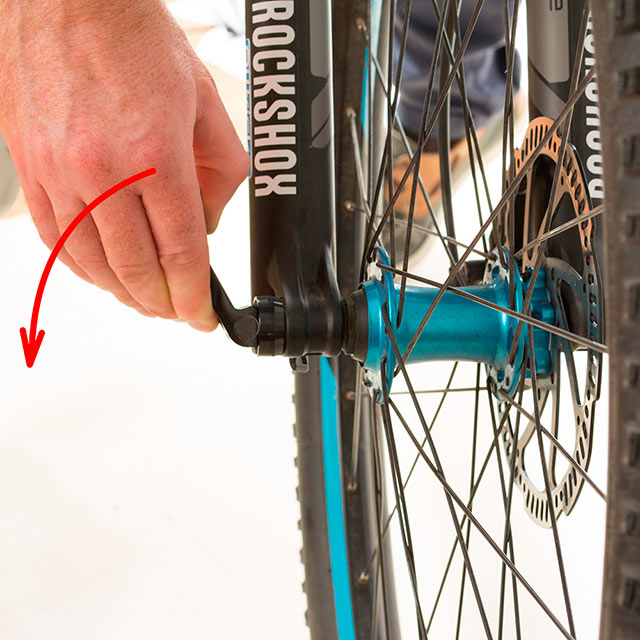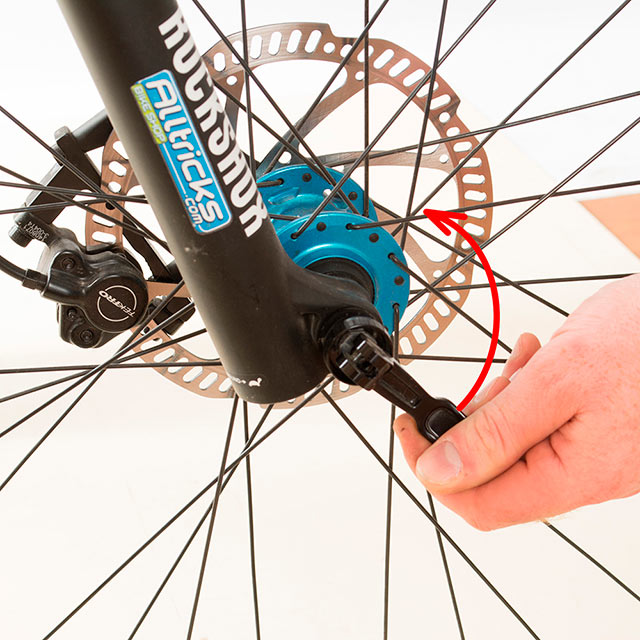How to change your inner tube

Tools
- Tyre iron
- Piston press
- New inner tube
- CO2
- Pumps
- Manometer
1/ Removing a rear wheel with quick release
For easy disassembly, shift gears until the smallest sprocket is reached.
2/ Removing a wheel with a through axle
If your wheel has a through axle type fitting (also called "Thru axle" or "Maxle"), you must unscrew it completely.
Tip: if your bike is equipped with hydraulic disc brakes, don't operate the brake when the wheel is disassembled, this will prevent you from having to push the pistons back to put back on the wheel.
3/ Preparation for dismantling
Push the two tyre bead wires towards the centre of the rim (this allows the tyre to "play" around the rim and greatly facilitates disassembly!).
Note: The tubeless rims have a small return that serves to hold the tyre bead wire more firmly, so you have to force a little more to unclip it from the rim.
4/ Removing the tyre

Carefully disassemble your tyre using one or more tyre irons to leverage the rim and the tyre. Be careful however: you should never use a metal object to carry out this operation, you risk damaging the tyre and the rim.
Tip: some tyres have a small hook at the rear that allows to fix it to a spoke of the rim. This facilitates the dismantling as you can you fix one tyre iron then go around the rim gradually with the second tyre iron.
Note: tyres with a flexible tyre bead wire and without reinforced sidewalls are easier to dismantle! With a little practice, you can even manage to remove them without a tyre iron!
5/ Removing the inner tube

Remove the punctured tyre.
6/ Checking the condition of the tyre

By feeling the inside of the tyre, check if no spines or other foreign objects are trapped inside the tyre tread. Failure to do so may cause your new inner tube to instantly burst when inflated.
You can also check the condition of the tyre bead wire: with time and wear, it can tear the tyre in some places.
7/ Pre-inflating the inner tube

In order to facilitate reassembly and to avoid pinching the inner tube during reassembly, slightly inflate the new inner tube (pump it moderately).
8/ Reassembling the tyre

Replace a first tyre bead wire in the groove of the tyre (1), fit the new inner tube, and take care to align the valve with the hole of the rim.
Replace the second tyre bead wire (2); if you can't mount it by hand, use a tyre iron and take care not to pinch the inner tube between the tyre and the rim.
9/ Choosing an inflation solution
There are many pumps and inflating systems on the market, here are some ways to help you choose:
Max pressure, capacity:
Although MTB tyres don't require very high pressures, the capacity of the pump is an important criterion because the more the pump tolerates high pressure the more robust and durable it is.
Compatibility:
There are two types of valves on the French market: presta (also called small valve) and schrader (also called big valve). Although today most pumps are compatible with both valve types, it's important to know to what extent it's compatible (if it's necessary to disassemble the head to change the type of valve for example)
Mounting on valve:
Different mounting systems can be found on the valve: force, force with fast locking, and with bolt connection. The latter is longer to put in place but makes the pump easier to use since it doesn't require to mount the head with force and doesn't allow any loss of pressure.
Manometer:
A pressure gauge to measure pressure.
CO2:
For high-speed inflation, some will prefer the use of a CO2 inflator. It consists of a cartridge of CO2 under high pressure and a firing pin. Some firing pins are equipped with an air flow control system. Here, too, various mounting systems can be found on the valve.
Inflation volume:
There are specific MTB pumps on the market, these have an oversized pump body to send more air per pump stroke. These pumps are generally referred to as "high volume" (HV).
10/ Inflating with a quick-locking hand pump

Make sure to use the pump in its configuration compatible with your valve: some pumps have 2 ends, others are removable to turn the valve head according to the valve used, and some accept any type of valve in the same opening without dismantling.
Before mounting the pump, "test" the valve by pressing it so as to release a little pressure. In fact, the pump sometimes remains "blocked" by the internal pressure of the inner tube.
Keep the valve in position so that it doesn't stay stuck in the tyre and then insert the valve into the pump head. It's necessary to force a little so that the valve penetrates thoroughly into the pump. Then, lock the head on the valve by pressing the locking lever.
Finally, pump to inflate the tyre; we recommend holding the front of the pump by holding the valve so that it doesn't force on the valve too much.
11/ Inflating with a compressed air system

There are mainly two types of firing devices on the market, the trigger type, once mounted on the valve, it's necessary to actuate an "on/ off" mechanism which makes it possible to inflate in fits and starts.
There are also mechanisms with precise control of the flow rate which make it possible to gradually transfer the air from the cartridge into the inner tube .
To use one of these systems, screw the cartridge on the firing pin and then screw the firing pin on the valve or force it up according to the system.
Caution: while exiting the cartridge, the air expands and cools down. If the decompression happens too fast, the cartridge will tend to freeze. Some firing pins come with a neoprene connecting sleeve on the cartridge. If you don't have one, we recommend you use gloves to avoid being "glued" to the cartridge!
12-1/ Tyre characteristics

1: Tyre dimensions in ETRTO standard
2: Tyre dimensions in inches
3: Pressure range tolerated in bar and PSI. Some pumps incorporate a manometer that allows you to control the pressure during inflation. Most pressure gauges allow you to read the pressure in bar and PSI through a double graduation.
12-2/ Tyre characteristics

Independent pressure gauges are also available to control the pressure after inflation.
13/ Reassembling the wheel

Reassemble the wheel making sure that the wheel axle is positioned correctly in the fork or frame legs. If the pistons have come closer, use the piston press to move them apart. For the rear wheel, place the chain on the cogset in rolling position and then, as for disassembly, remove the derailleur to allow the wheel axle to be positioned correctly.
14/ Preventing punctures

Before considering replacing your tyres, it's important to understand why you have a flat tyre:
• The inner tube has 2 parallel slots, which means that you have "pinched" your inner tube between the tyre and the rim. This type of puncture is due to the fact that you were driving with an underinflated tyre or with a tyre that wasn't adapted to the terrain.
In order to avoid this type of puncture, you can adapt the pressure to the terrain: the rougher the terrain, the more pressure you can build up. However, this will reduce the grip and steering sensations. You can also choose a tyre with reinforced sidewalls and casing, specifically designed for this type of terrain.
• The inner tube has a small hole: this means you probably got a pucnture from a thorn. It's then necessary to check the condition of the tyre: if it presents a high wear or cracks, it's time to change it. If this type of puncture is recurrent we advise you to favour the tyres with reinforced casing.
The choice of the inner tube is also important
There are different sections, you have to choose one compatible with the section of your tyre.
There are also anti-puncture strips on the market, to be placed inside the tyre under the tread. This provides additional protection.
You'll also find (thicker) reinforced inner tubes and inner tubes with a preventive (a liquid that solidifies in contact with the air, thus closing the small punctures).
Finally, the transitionto the tubeless also helps to prevent this type of small puncture: if a thorn pierces the tyre, just remove the thorn and let the preventive plug the hole and then re-inflate the tyre. You're good to go! The only drawback is that it's necessary to disassemble regularly to apply the preventive again.




















